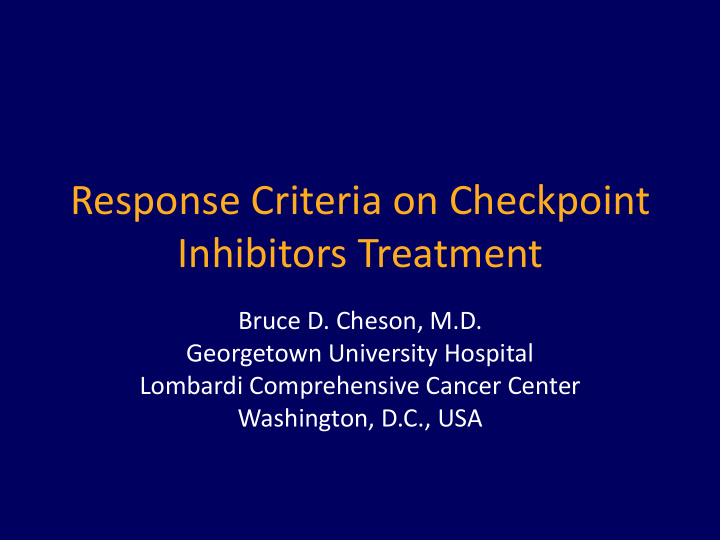



Response Criteria on Checkpoint Inhibitors Treatment Bruce D. Cheson, M.D. Georgetown University Hospital Lombardi Comprehensive Cancer Center Washington, D.C., USA
Classical Hodgkin ’ s Lymphoma CD15 CD30 CD45
IFN ! -mediated up-regulation of PD-L1/PD-1-mediated tumor PD-L1 Inhibition of tumor cell killing receptor Priming and Activation of T cells Immune cell modulation of T cells Stromal PD-L1 modulation of T cells PD-L2 mediated inhibition of TH-2 T cells PD-L1 plays an important role in dampening the anti-tumor immune response Chen DS, Irving BA, Hodi FS. Clin Cancer Res. 2012;18:6580. CONFIDENTIAL INFORMATION – DO NOT COPY OR FORWARD
Hodgkin Lymphoma - Response to Nivolumab SD (13%) PR (70%) CR (17%) Ansell et al. N Engl J Med. 2014 Dec 6.
A New Problem • ~15% of solid tumor pts have a flare response on immunomodulatory agents (CPIs) • Confused with PD • Result in premature termination
Percent Change from Baseline of Early (A) vs Late (B) Pseudoprogression Hodi et al JCO 34:1510, 2016
Distribution of Lesions with Atypical Responses Hodi et al JCO 34:1510, 2016
Core Concepts of IRC • Confirmation of progression via a subsequent scan to detect delayed responses (time point to be determined by characteristics of the disease) • Measuring new lesions to include in total tumor volume • Accounting for durable SD as benefit • Treating beyond conventional PD if clinically appropriate Wolchok et al, Clin Cancer Res 15:7412, 2009
Agents That Induce Flare Reactions in Lymphoma • Lenalidomide • Rituximab • Brentuximab vedotin • Ibrutinib • Check point inhibitors • Potential agents – Bispecific antibodies – Engineered T-cells
May 2015 August 2015 October 2015 December 2015 Courtesy S. Ansell
Immune Response Criteria (IRC) * • Not applicable to lymphoma: – Rely on RECIST rather than Lugano – Timing of response assessment differs – Confirmatory studies not required with lymphoma – Definition of PD differs – Do not include PET-CT – Tumors are always abnormal; lymphomas involve nodes which are normally present • Normal size despite involvement • Enlarged despite non-involvement * Wolchok et al, Clin Cancer Res 15:7412, 2009
Discordance Between IRC and the Lugano Classification • Lymphomas often have non-measurable disease, imperceptible on CT – Bone marrow – Soft tissue involvement • Cannot be integrated into tumor burden
Discrepancy Between Lugano and Immune Response Criteria * * * * * * Restaging FDG-PET/CT 1 Restaging FDG-PET/CT 2 12 weeks 20 weeks
Discordance Between IRC and Lugano • Restaging PET-CT shows resolution of lesions • If persistent CT lesions would be considered a PR by IRC • Considered CR by Lugano if no longer FDG avid
Dicrepancy Between Lugano and IRC * * Restaging Baseline PET/CT PET/CT and and Contrast- Contrast- enhanced CT enhanced CT
LRF Sponsored Workshop 20.11.15: Assessment of Response in Patients On Immunmodulatory Agents
Immune Response Workshop • Included presentations from investigators and industry representatives on experience with check point inhibitors • Discussed the relevance of solid tumor IRC to lymphoma • Determined lymphoma-specific criteria were needed • Developed Lymphoma Response to Immunomodulatory Therapy Criteria (LyRIC)
LyRIC: Lymphoma Response to Immunomodulatory Therapy Criteria
LyRIC: Indeterminate Response (IR) • Provisional term • To identify lesions that may be flare vs PD • Does not make direct reference to underlying mechanism • Allows appropriate patients to remain on treatment – until reassessment to confirm or refute PD – or biopsy proven disease
Definitions of Types of IR IR1: Increase in overall tumor burden (by SPD) of ≥50% of up to 6 measurable lesions in the first 12 weeks of therapy, without clinical deterioration Cheson et al, Blood, e-pub online, Sept 2016
IR1 * * * * * * * * * * Baseline CT Restaging CT 1- 3 wks Restaging CT 2- 7 wks Restaging CT 3-13 wks Courtesy H. Jacene
Definitions of Types of IR IR2: Appearance of new lesions; or growth of one or more existing lesion(s) ≥50%; at any time during treatment; occurring in the context of lack of overall progression (<50% increase) of overall tumor burden, by SPD of up to 6 lesions at any time during the treatment.
IR2 Courtesy H. Jacene
Definitions of Types of IR IR3: Increase in FDG uptake of one or more lesion(s) without a concomitant increase in lesion size or number
IR(3) an increase in FDG uptake of one or more lesions suggestive of lymphoma without a concomitant increase in size of those lesions meeting PD July 2, 2014 Sept 3, 2014 Courtesy L. Schwartz
Follow-up of IR • Repeat scan in ~12 wks (earlier if indicated) • PD if: – IR1 – further increase > 10% in SPD • > 5 mm in 1 dimension for lesions < 2 cm • > 10 mm for lesions > 2 cm – IR2 – new lesion added to SPD (unless benign) and, if >50% increase – PD – IR3 – PD if increase in size or new lesions
Use of the IR Category • Incorporated as a secondary endpoint of future clinical trials of immunomodulatory agents • Allow for treatment past “PD” if clinically indicated • Collect data to determine appropriateness of this approach
Conclusions • PET-CT is standard for restaging FDG-avid lymphomas • Use of immunotherapies may result in false- positive/flare reactions • LyRIC criteria provide guidance as to how to assess such responses • Incorporation of other methodologies may increase specificity • Reduce number of patients removed from potentially effective therapies
Recommend
More recommend